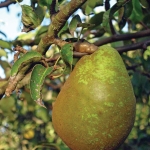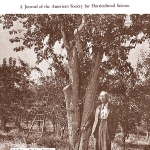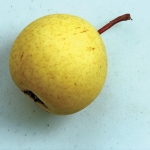Old Home x Farmingdale pear rootstocks, which have been widely used by the U.S. pear industry for many years, should actually be called Old Home x Bartlett, it turns out.
Genetic fingerprinting done at the U.S. Department of Agriculture’s National Clonal Germplasm Repository in Corvallis, Oregon, revealed that it is impossible for Farmingdale to be the pollen parent of any of the several OHxF rootstocks tested.
This prompted Joseph Postman, curator of the repository, to retrace the story behind the OHxF rootstocks. It begins a century ago when Oregon State University pomologist Frank Reimer began scouring the world for pear germplasm with resistance to fireblight, a disease that had made its first appearance in Oregon’s Rogue River Valley in 1906. Reimer was the first superintendent of the OSU Southern Oregon Experiment Station near Medford.
Two of his most important discoveries came from a 1915 visit with fruit grower Benjamin Buckman in Farmingdale, Illinois. One was the cultivar Farmingdale, an open-pollinated seedling that Buckman had found near a d’Anjou pear tree on his farm. The other was Old Home, a seedling that had come from a nursery in Illinois some years earlier. Both these trees were completely free of fireblight. Reimer took scion wood of Old Home back to the Southern Oregon Experiment Station and had Farmingdale scions sent to him several years later.
After more than a decade of testing the many pear species in OSU’s collection, Reimer found only three European cultivarsFarmingdale, Longworth, and Old Homethat had excellent blight resistance when used as trunk stocks.
After Buckman died, the original Farmingdale and Old Home trees in Illinois were destroyed, and the trees at OSU became the primary source of nursery stock.
Fireblight resistant
Reimer found in the 1930s that when Farmingdale was used as a pollen parent in crosses with other blight-resistant selections, a high percentage of the resulting seedlings were highly resistant to fireblight, especially when the seed parent was Old Home.
Although crosses between other blight-resistant parents also produced seedlings that were resistant to blight, many of those seedlings became infected when a susceptible cultivar such as Bartlett or Bosc was grafted onto them. In those cases, fireblight could spread from an infected cultivar across the graft union into the rootstock. In contrast, the OHxF seedlings were resistant even to the spread of fireblight from a grafted cultivar.
One of Reimer’s goals was to establish a mother block of Old Home and Farmingdale trees in Medford to generate seed for producing blight-resistant seedling rootstocks. However, Lyle Brooks, owner of Daybreak Nursery in Forest Grove, Oregon, became concerned about the variability of pear cultivars grafted onto OHxF seedling rootstocks. Collaborating with Dr. Mel Westwood at OSU, Corvallis, he set out to develop clonal rootstocks from those two parents.
In 1950, he obtained half a kilogram of seeds from what he described as an isolated block of Old Home trees planted with Farmingdale pollinizers at the Canadian Department of Agriculture Research Unit near Summerland, British Columbia. It now appears that Bartlett must have been planted in the vicinity of the Summerland pear block where Brooks obtained the seeds.
Patented
Of the 2,000 seedlings he grew from those seeds, 516 were planted in a nursery block for evaluation. Thirteen of the more easily propagated selections were evaluated in trials for disease resistance and many other traits, including hardiness, precocity, compatibility with pear varieties, and tolerance to pear decline, as well as resistance to fireblight.
Several, including OHxF 69, 87, 97, and 333, were patented in 1988 by Carlton Nursery, which was operated by the Brooks family. The rootstocks have been propagated worldwide and continue to be in high demand, though some lack the size control and precocity needed for high-density orchards.
More than 40 of the OHxF selections are preserved at the National Clonal Germplasm Repository. In 2009, Postman and ARS plant geneticist Dr. Nahla Bassil did genetic fingerprinting of pears in the collection and found that d’Anjou was very likely the maternal parent of Farmingdale, as Buckman and Reimer had suspected.
They then went on to do genetic paternity testing of six OHxF selections (51, 69, 87, 97, 230, and 333), along with a number of other cultivars. All the OHxF selections proved to be related to Old Home, but the tests showed that Farmingdale was highly unlikely to be a pollen parent. On the other hand, there was a strong indication that Bartlett was genetically related to all those selections.
Puzzle
Postman said this explained what had been something of a puzzle to him over the years: While fruit of the OHxF selections in the germplasm collection resembles Old Home, which has a distinctive round shape, it does not at all resemble Farmingdale. The shape of OHxF fruit tends to be intermediate between that of Old Home and Bartlett. Similarly, the foliage of the OHxF selections resembles the foliage of Old Home but not Farmingdale.
Lynnell Brandt, president of Brandt’s Fruit Trees in Yakima, Washington, said his father Everette worked at Carlton Nursery during the time when Brooks was testing the OHxF rootstocks to identify the most promising ones. Lynnell, who joined the staff of Carlton Nursery in the late 1970s, said he felt confident that both Brooks and Westwood believed that Farmingdale was the pollinizing parent.
“Who were we to question those two?” he asked. “They were the world’s leaders in pear understocks. And it seems strange to me, because Lyle would definitely notice the difference between Bartlett and Farmingdale. He would have known the leaves were different.”
Postman said the fact that the OHxF rootstocks have no Farmingdale heritage means that the highly fireblight-resistant Farmingdale is under-represented in the pedigrees of the pear rootstocks currently used in the pear industry as well as in the parent material being used in rootstock breeding programs.
Although Farmingdale is not likely to instill either dwarfing or precocity in its offspring, Farmingdale germplasm should be reconsidered if fireblight resistance is to be an important genetic trait in future pear cultivars and rootstocks, he suggests.
Future DNA fingerprinting in the USDA pear gene bank should help breeders better understand the paternity of parents when making crosses to develop improved varieties, he added.
The question now is whether the OHxF rootstocks should be renamed. The patent expired in 2005, so no one owns the OHxF name.
“Water’s gone under the bridge for so long, so whether they’re Bartlett or Farmingdale, everyone will probably continue to call them OHxF so things don’t get confused,” said Joe Dixon, sales representative with Carlton Plants. “There’s really nobody who would rename them or have the rights to do so, I don’t think.” •









Leave A Comment